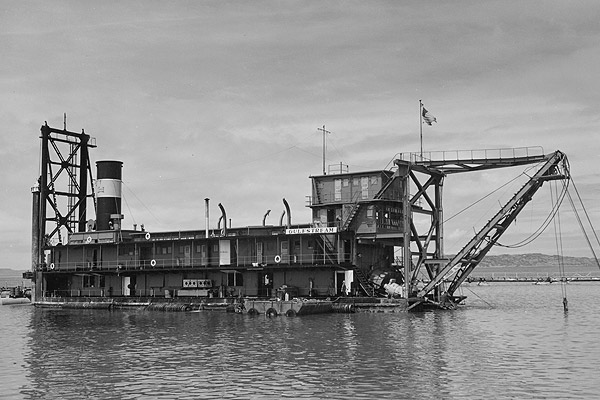
U.S. dredge Gulfstream
It's a bit misleading to refer to the Mississippi River as just a river: it's also infrastructure. John McPhee's "Atchafalaya" is a classic piece of journalism that details the vast, expensive history of turning the big muddy river into a shipping superhighway:
The river, after all, was not just what he could see in 1987. It was also the product of history – the geological history of the region, and then the human history overlaid on it – history that includes politics, warfare and centuries of engineering. McPhee mastered this vast backstory, but he was not yet done. He also became intimately acquainted with the colossal system of levees and weirs that line the Mississippi: a grand construction that is both longer and wider than the Great Wall of China.
The upper Mississippi has avoided low-water shipping restrictions because of the lock-and-dam system, but the lower Mississippi has been operating under restrictions all summer due to the drought. And an 11-mile stretch was just closed yesterday, with no timetable for its opening. But ships on the river have been running at lower capacity with some frequency, due to consistent underfunding:
The deteriorating lock system remains at risk of failure, and dredging will be needed to encompass new larger ships that will be possible with the expansion of the Panama Canal, due to open in late 2014. The U.S. Army Corps of Engineers has the responsibility to maintain a depth of 45 feet on the lower Mississippi River, but, due to funding issues, has not been able to dredge to maintain an adequate navigable channel, limiting ships to 42-foot draft, meaning the vessel holds fewer soybeans.
Even before this summer's drought brought the water down to levels not seen in 25 years, boats still had to come under the 45-foot draft, at least until a ship ran aground and finally brought the Congressional stalemate to a halt. It's very much a political issue, and one that's a result of the current political climate:
Opportunities to initiate any new water resource projects are tied to the passing of a new WRDA bill [Water Resources Development Act], but in the last decade these opportunities have been few and far between. Many observers and policymakers attribute the infrequency of WRDA bills to rising partisanship in Congress and to the politicization of new spending measures. Their outlook for new WRDA bills is accordingly grim.
[snip]
As a practical matter, most Army Corps project funding in recent years has been from appropriations earmarks, which direct funding to specific recipients or locations. In light of the Republican Party’s current policy favoring a moratorium on congressional earmarks, which has been effective since 2009 and appears likely to remain so at least through the next election, this source of funding this source of funding has dried up. Instead, Army Corps project funding is provided without explicit congressional guidance as to the specific projects on which it should be spent.
In and of itself, this is quite remarkable—the 2007 WRDA bill was passed with substantial bipartisan support—there are a lot of Republicans along the lower Mississippi—which overrode a Bush veto, the first of his administration. WRDA bills are usually enacted every two years; there hasn't been a new one since then. Instead, the Army Corps of Engineers has been faced with substantial budget cuts, leading to cuts in maintenance dredging:
Without the additional funding for dredging, many officials have warned for more than a year that the river could be restricted in the near future to ships with a depth of 38 feet.
The limitations could prompt larger ships to carry less cargo, or unload to smaller ships before passing through the channel, spiking costs and affecting shipping operations not just in southeast Louisiana, but also in several states along the river.
Fortunately, or something, the grounding of a ship led to immediate funding, just as last year's floods and this year's drought led to increased dredging. Historic crises have led to many changes on the Mississippi; perhaps this year's drought will be a reminder that the big river isn't just at risk from the environmental climate, but the political one as well.
Photograph: U.S. Army Corps of Engineers


